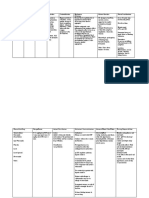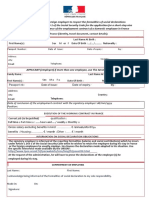Centrifugal Fans Using Vibration Analysis To Detect Problems
Centrifugal Fans Using Vibration Analysis To Detect Problems
Uploaded by
Givon Da AnneistaCopyright:
Available Formats
Centrifugal Fans Using Vibration Analysis To Detect Problems
Centrifugal Fans Using Vibration Analysis To Detect Problems
Uploaded by
Givon Da AnneistaOriginal Title
Copyright
Available Formats
Share this document
Did you find this document useful?
Is this content inappropriate?
Copyright:
Available Formats
Centrifugal Fans Using Vibration Analysis To Detect Problems
Centrifugal Fans Using Vibration Analysis To Detect Problems
Uploaded by
Givon Da AnneistaCopyright:
Available Formats
CENTRIFUGAL FANS USING VIBRATION ANALYSIS TO DETECT PROBLEMS
PRINCIPLES OF OPERATION: Centrifugal fans are one of the most versatile and widely used pieces of rotating mechanical equipment found today. The fan is an essential part of all heating, air conditioning, air handling and ventilation systems. Fans are used in automobiles, homes, offices, industry and many other applications. The most common use of centrifugal fans is to move air and gases for air handling or ventilation systems. The basic principal of operation for a centrifugal fan is that a shaft mounted rotating wheel (impeller) inside a scroll type housing imparts energy to the air stream or gas being moved by the fan. Centrifugal fans utilize centrifugal force (thus their name) to increase the velocity of the air as it passes between the fan wheel blades and exits at the tip of the fan wheel. This action converts mechanical energy (shaft torque) into kinetic energy by acceleration of the air stream to a higher velocity (velocity pressure) and potential energy (static pressure). Fans are velocity generators for the air being moved. FAN PERFORMANCE: Fans follow basic laws of performance. These are useful in determining the effect of changes to the operating parameters and can help determine the cause of operational problems. These basic laws apply to any type of fan or fan system. 1. The air volume varies directly as the fan wheel (impeller) rotating speed. 2. The pressure (static, velocity and total) varies as the square of the fan wheel (impeller) speed. 3. The power required (horsepower) varies as the cube of the fan wheel (impeller) speed. 4. At constant speed and capacity, the pressure and power vary directly as the density of the air moved (lbs per cubic foot). 5. At constant pressure, the speed, capacity and power vary inversely as the square root of the density of the air. 6. For a constant weight of air: a. The speed, capacity, and pressure vary inversely with the density of the air. b. The horsepower varies inversely with the square of the density. DETECTING FAN PROBLEMS USING VIBRATION ANALYSIS: Fans are subjected to operational forces generated by their operating speed, static pressures and system arrangement. These operational forces cause forced vibration and may originate from the rotating parts themselves. Unbalanced fan wheels and drive sheaves are examples of forces that cause force and couple unbalance. Axial load on fan bearings is generated primarily by the negative static pressure at the inlet of the fan wheel. The relationship between a fans operating conditions (flow quantity, pressure, speed and arrangement) generate forces that cause vibration and problems that reduce the expected life of the bearings and fan components.
Copyright 2014 Technical Associates of Charlotte, P.C. www.technicalassociates.net
Page 1
CENTRIFUGAL FANS USING VIBRATION ANALYSIS TO DETECT PROBLEMS
SUMMARY OF COMMON FAN VIBRATION PROBLEMS: (Detected Using Vibration Analysis) 1. Unbalance of Overhung Fan Rotating Parts (Fan Wheel or Drive Sheave): Overhung Rotor Unbalance will cause high 1X RPM in both the axial and radial directions. Axial readings tend to be in-phase and steady, whereas radial phase readings might be unsteady. Overhung rotors have both force and couple unbalance, each of which will likely require correction. Thus, correction weights will most always have to be placed in 2 planes to counteract both force and couple unbalance. 2. Unbalance of Center-Hung Fan Wheel: Force Unbalance will be in-phase and steady. Amplitude due to unbalance will increase by the square of speed (a 3X speed increase = 9X higher vibration). 1X RPM is always present and normally dominates the spectrum. This can be corrected by placement of only one balance correction weight in one plane at the Rotor center of gravity (CG). Approximately 0 phase difference should exist between outboard and inboard horizontal, as well as between the outboard and inboard vertical direction. 3. Belt Drive Problems and Drive Misalignment: Sheave misalignment is a very common problem with belt-driven fans. When it is present, the vibration at fan speed is typically the highest vibration peak in spectra taken on the motor. It can be confirmed by measuring phase in the axial direction at fan speed. Misalignment will cause phase differences at or approaching 180 between the motor and fan inboard bearings (closest to the pulleys) with phase comparisons made at fan speed. 4. Fan Stall Condition: This unstable condition can cause the ductwork to vibrate excessively and produce a howling sound. In many cases subsynchronous frequencies will occur at approximately 66%-75% of the fan RPM that will oscillate in amplitude and will produce subsynchronous sidebands around 1X blade pass frequency (where blade pass frequency = #blades X RPM). 5. Fan Surge Condition: Surge is a condition resulting from improper fan selection or operation and is recognized by the whoosh sound as air surges back through the fan. The frequency is subsynchronous typically at 33%-50% of fan running speed. 6. Fan Bent Shaft Condition: Bent shaft problems cause high axial vibration with axial phase differences tending towards 180 on the same rotor. Dominant vibration normally occurs at 1X RPM if bent near shaft center, but at 2X RPM if bent near the coupling. Dial indicators can be used to confirm a bent shaft. 7. Misalignment Condition: Fan shaft misalignment is a condition typically found in direct drive overhung fans. Misalignment is a condition where the centerlines of two (2) connected shafts typically at the coupling do not coincide. Parallel misalignment is a condition where the shaft
Copyright 2014 Technical Associates of Charlotte, P.C. www.technicalassociates.net Page 2
CENTRIFUGAL FANS USING VIBRATION ANALYSIS TO DETECT PROBLEMS
centerlines are parallel, but not aligned. The radial vibration spectra will show 2X RPM higher than 1X and a 3X higher than normal. Axial 1X and 2X will be low with 180 out of phase across the coupling in the radial and axial direction. Angular misalignment will show high axial 1X and some 2X and 3X RPM 180 out of phase axial across the coupling. 8. Belt Wear: Belt wear can be detected by the presence of frequencies not only at Belt RPM, but also at multiples of belt RPM (harmonics). Typically, when belt wear is present, the peak at 2X belt RPM will exceed the peak at 1X belt RPM. If belt wear is significant, it will usually produce many harmonics of belt speed. Note that belt speed will always be lower than either the motor or fan speed (RPM). 9. Fan Bearing Problems: Peaks (with harmonics) at nonsynchronous frequencies is a symptom of rolling element bearing wear. Short bearing life for fans is typically the result of poor bearing selection for the application, such as excessive loads, poor lubrication or high temperatures. If the model number and manufacturer of the bearings are known, then the specific fault frequencies for the outer race, inner race, rolling elements and cage can be determined. These fault frequencies for such bearings are found within tables of most predictive maintenance (PdM) software today. 10. Air Flow and Air Turbulence Problems: Fans will normally have a peak in the spectrum at blade pass or vane pass frequency. Increased amplitude of the peak indicates the possibility of clearance problems at the discharge of the scroll or flow restrictions causing high discharge pressure. Severe flow turbulence will generate subsynchronous peaks and a raised noise floor. This article is intended to be a summary of common fan problems that vibration analysis can detect and identify. Formal vibration analysis training and balancing training from an organization like Technical Associates of Charlotte can provide an analyst with valuable information and understanding of fan problems detected by vibration analysis. Specialized vibration training courses such as time waveform analysis can also be beneficial. In addition, most training service providers offer vibration analysis certification through a written examination as confirmation of the students comprehension of the course material and the basics for detecting common fan problems using vibration analysis. James David Kesler Sales/Operations Manager Technical Associates of Charlotte 1230 West Morehead St., Suite 400 Charlotte, NC 28208
Copyright 2014 Technical Associates of Charlotte, P.C. www.technicalassociates.net
Page 3
You might also like
- Municipality of Guiguinto Comprehensive Develeopment Plan CDP 2022 2027Document95 pagesMunicipality of Guiguinto Comprehensive Develeopment Plan CDP 2022 2027MILDRED LLARENASNo ratings yet
- Vibration Basics and Machine Reliability Simplified : A Practical Guide to Vibration AnalysisFrom EverandVibration Basics and Machine Reliability Simplified : A Practical Guide to Vibration AnalysisRating: 4 out of 5 stars4/5 (2)
- Controlling Fan VibrationDocument10 pagesControlling Fan VibrationAlejandro Aguirre100% (1)
- Vibration DiagnosticsDocument54 pagesVibration Diagnosticshzq1e100% (1)
- Case Histories in Vibration Analysis and Metal Fatigue for the Practicing EngineerFrom EverandCase Histories in Vibration Analysis and Metal Fatigue for the Practicing EngineerRating: 4.5 out of 5 stars4.5/5 (3)
- Why Industrial Bearings Fail: Analysis, Maintenance, and PreventionFrom EverandWhy Industrial Bearings Fail: Analysis, Maintenance, and PreventionNo ratings yet
- Vibration Analysis of Centrifugal FansDocument18 pagesVibration Analysis of Centrifugal FansMohd Asiren Mohd Sharif100% (4)
- Vibration Analysis of PumpDocument3 pagesVibration Analysis of Pumpvijayabaskaran PalanisamyNo ratings yet
- ED600Document5 pagesED600Mohamed TahounNo ratings yet
- Vibration Diagnostic ChartDocument49 pagesVibration Diagnostic Chartujepadounk100% (2)
- 04 Fault Analysis 2006Document57 pages04 Fault Analysis 2006peach5100% (2)
- Non-Engine Order Blade Vibration in A High Pressure CompressorDocument13 pagesNon-Engine Order Blade Vibration in A High Pressure CompressorCatarina FernandesNo ratings yet
- Fan VibrationDocument6 pagesFan VibrationRavi Deshmukh100% (2)
- Vibration DiagnosticsDocument54 pagesVibration Diagnosticsahadryk80% (5)
- Advanced Field BalancingDocument33 pagesAdvanced Field BalancingAmir Mahmoud Mahdavi Abhari100% (1)
- Vibration Signature AnalysisDocument16 pagesVibration Signature Analysisabolfazlkhaki100% (1)
- An Endusers Guide To Centrifugal Pump RotordynamicsDocument16 pagesAn Endusers Guide To Centrifugal Pump RotordynamicsManjunath AithalNo ratings yet
- Machinery Vibration DiagnosticsDocument22 pagesMachinery Vibration Diagnosticstonytayic100% (7)
- Condition MonitoringDocument52 pagesCondition MonitoringAbdullaHanèèfa100% (3)
- Types of Vibrations On ShipsDocument21 pagesTypes of Vibrations On ShipsbahrulNo ratings yet
- Sereema Wind Turbine Rotor MonitoringDocument9 pagesSereema Wind Turbine Rotor MonitoringMoroko69No ratings yet
- Diagnosis of Centrifugal Pump Faults Using Vibration MethodsDocument12 pagesDiagnosis of Centrifugal Pump Faults Using Vibration MethodsHatem ShawkiNo ratings yet
- Vibration Diagonistic ChartDocument1 pageVibration Diagonistic Chartjawadhussain1100% (11)
- The Relatioship of Vibration To Problems in Centrifugal Pumps - CheDocument7 pagesThe Relatioship of Vibration To Problems in Centrifugal Pumps - Chehtaboada2008100% (1)
- Harmonic Analysis of The Cam ShaftDocument3 pagesHarmonic Analysis of The Cam ShaftramsastryNo ratings yet
- Operator PresentationDocument41 pagesOperator PresentationRoberto OrtegaNo ratings yet
- Fans. Balance, Vibration, and Vibration AnalysisDocument4 pagesFans. Balance, Vibration, and Vibration AnalysisTxomin RodríguezNo ratings yet
- Signature AnalysisDocument49 pagesSignature AnalysisVirgilio50% (2)
- Introduction To Vibration & Pulsation in Reciprocating Compressors (Beta)Document28 pagesIntroduction To Vibration & Pulsation in Reciprocating Compressors (Beta)Fabbrox100% (1)
- Balance System (Without 4 Screw Being Attached) : Z 19.87 MGDocument4 pagesBalance System (Without 4 Screw Being Attached) : Z 19.87 MG蒲俊雄No ratings yet
- Fan Surge Information Tbn006 PDFDocument4 pagesFan Surge Information Tbn006 PDFShellFugateNo ratings yet
- 2 VibrationDocument73 pages2 VibrationHassan SamyNo ratings yet
- 7 - Eccentricity, Hydraulic and AerodynamicDocument13 pages7 - Eccentricity, Hydraulic and Aerodynamickurniuawan6723No ratings yet
- Dynamic BalancingDocument34 pagesDynamic Balancingade_salman100% (1)
- RegulationsDocument19 pagesRegulationsDuruthu AbhishekNo ratings yet
- Use of Dissipative SilencersDocument9 pagesUse of Dissipative SilencersmukeshkumarjNo ratings yet
- Technical Paper FlowDocument20 pagesTechnical Paper FlowTorus EngenhariaNo ratings yet
- Field Balancing and Vibration Reduction of Large Power Generation Steam TurbinesDocument31 pagesField Balancing and Vibration Reduction of Large Power Generation Steam TurbinesAbdulrahman Alkhowaiter100% (2)
- Envelope BearingDocument14 pagesEnvelope BearingHussein Razaq100% (2)
- Vibration: SourcesDocument4 pagesVibration: SourcesMuthu SaravananNo ratings yet
- Basics of Vibration MonitoringDocument14 pagesBasics of Vibration MonitoringsandystaysNo ratings yet
- Bend Shaft Vibration SpectrumDocument6 pagesBend Shaft Vibration SpectrumAvnish DubeyNo ratings yet
- Recommended Approach To Control Vibration From Cylinder Gas ForcesDocument14 pagesRecommended Approach To Control Vibration From Cylinder Gas ForcesKelly Eberle100% (1)
- Quiz 1Document3 pagesQuiz 1Alan MejiaNo ratings yet
- Dynamic Balancing ExplainedDocument14 pagesDynamic Balancing ExplainedMudassar Ali RongaNo ratings yet
- Monitoring and Analysis of Machine VibrationDocument6 pagesMonitoring and Analysis of Machine VibrationAvinashNo ratings yet
- CH4Document11 pagesCH4wawalandNo ratings yet
- Misalignment Exp.Document16 pagesMisalignment Exp.aadityakurte010403No ratings yet
- T5pg133 148Document16 pagesT5pg133 148Maria Helena FigueiredoNo ratings yet
- Crankshaft Torsion and Dampers PDFDocument9 pagesCrankshaft Torsion and Dampers PDFjeyaselvanm100% (1)
- Diff Between Blower and FanDocument5 pagesDiff Between Blower and FanKarthikRajuNo ratings yet
- Equipment VibrationDocument34 pagesEquipment VibrationVirgilioNo ratings yet
- Southern Marine Engineering Desk Reference: Second Edition Volume IiFrom EverandSouthern Marine Engineering Desk Reference: Second Edition Volume IiNo ratings yet
- Vibrations of Power Plant Machines: A Guide for Recognition of Problems and TroubleshootingFrom EverandVibrations of Power Plant Machines: A Guide for Recognition of Problems and TroubleshootingNo ratings yet
- Influence of System Parameters Using Fuse Protection of Regenerative DC DrivesFrom EverandInfluence of System Parameters Using Fuse Protection of Regenerative DC DrivesNo ratings yet
- Chemistry 1.2 NotesDocument13 pagesChemistry 1.2 NotescheeheNo ratings yet
- Receivables Turnover RatioDocument69 pagesReceivables Turnover RatioJulie UgsodNo ratings yet
- STD Viii PSG 2Document14 pagesSTD Viii PSG 2Md. Masroor-ul AlamNo ratings yet
- Presence of Garcinol in Garcinia Binucao FINALDocument22 pagesPresence of Garcinol in Garcinia Binucao FINALattyvan100% (1)
- Drug StudyDocument8 pagesDrug StudyJuan de Vera100% (4)
- U Max 030521Document65 pagesU Max 030521Emmanuel ValiaoNo ratings yet
- Miss Brytons Classroom Area Right OneDocument2 pagesMiss Brytons Classroom Area Right Oneapi-416734680No ratings yet
- Design Options For Transportation NetworkDocument14 pagesDesign Options For Transportation NetworkpinakNo ratings yet
- Individual Cognitive Behavioral Therapy and Combined Family/individual Therapy For Young Adults With Anorexia Nervosa: A Randomized Controlled TrialDocument16 pagesIndividual Cognitive Behavioral Therapy and Combined Family/individual Therapy For Young Adults With Anorexia Nervosa: A Randomized Controlled TrialAggelou MayaNo ratings yet
- 2023-06-14-APLH - ns-jPMorgan-Indian Hospitals Ripe To Absorb Expansion - Initiating Cove... - 102397906Document65 pages2023-06-14-APLH - ns-jPMorgan-Indian Hospitals Ripe To Absorb Expansion - Initiating Cove... - 102397906Vikram SharmaNo ratings yet
- Lec 1Document31 pagesLec 1Nada ElDeebNo ratings yet
- W-8Ben: Certificate of Foreign Status of Beneficial Owner For United States Tax Withholding and Reporting (Individuals)Document2 pagesW-8Ben: Certificate of Foreign Status of Beneficial Owner For United States Tax Withholding and Reporting (Individuals)Rebecca AntoniosNo ratings yet
- Anti Money Laundering (AML) Learnings From Banks: Compliance Group-AML July 16, 2010Document23 pagesAnti Money Laundering (AML) Learnings From Banks: Compliance Group-AML July 16, 2010Mahapatra Milon100% (1)
- Impact of Perceived Social Support On Psychological Wellbeing in Young AdultsDocument7 pagesImpact of Perceived Social Support On Psychological Wellbeing in Young AdultsIJRASETPublicationsNo ratings yet
- Tips To Crack Tricky Interview QuestionsDocument2 pagesTips To Crack Tricky Interview QuestionsHema KrishnaNo ratings yet
- Our Influence As EU CitizensDocument9 pagesOur Influence As EU CitizensDaiana AndreeaNo ratings yet
- Absolute Value Equations and InequalitiesDocument20 pagesAbsolute Value Equations and Inequalitieslelei bljdNo ratings yet
- 4x35 RM 2XYDocument1 page4x35 RM 2XYjamilNo ratings yet
- Resume Dipta RoyDocument3 pagesResume Dipta RoyRoy DiptoNo ratings yet
- Online Summer ReportDocument13 pagesOnline Summer ReportDevender DhakaNo ratings yet
- Yuxuan Full PLLDocument4 pagesYuxuan Full PLLRichy UdilNo ratings yet
- Anatolyev ProblemnikDocument116 pagesAnatolyev ProblemnikJosé Miguel Carrasco100% (1)
- Manuscript 1 PDFDocument8 pagesManuscript 1 PDFDiyar NezarNo ratings yet
- User Manual 9400UX - 9400UX FLAT März2004Document314 pagesUser Manual 9400UX - 9400UX FLAT März2004vonallesua100% (2)
- Date of Birth: Usual Non-Tax Resident Employer in France (Identity, Travel Document, Contact Details)Document2 pagesDate of Birth: Usual Non-Tax Resident Employer in France (Identity, Travel Document, Contact Details)Triyambh OjhaNo ratings yet
- BIM BookDocument95 pagesBIM BookKamal Shawky80% (10)
- Louis Kahn Position in Sustainable Architecture: August 2014Document10 pagesLouis Kahn Position in Sustainable Architecture: August 2014Mae PuyodNo ratings yet
- E-Nkap v1.0.0 Quickstart GuideDocument14 pagesE-Nkap v1.0.0 Quickstart GuideFreeuserNo ratings yet
- Foreign Language MandarinDocument12 pagesForeign Language MandarinFar Mie100% (2)

























































































